City Diagnosis as a Strategic Component in Preparing Urban Areas for Climate Change: Insights from the ‘City with Climate’ Project
Abstract
Featured Application
Abstract
1. Introduction
2. Methods
- Division of the city area into spatial units;
- Selection of assessment criteria;
- Collection of data for the calculation of criterion values;
- Selection of weights for individual criteria;
- Calculation of criterion values and their normalised values;
- Calculating the products of the normalised criterion values and the weights of a criterion;
- Calculating the sum of the products and performing the ranking of the spatial units;
- Drawing up a table and map composition.
3. Study Area
3.1. Bielsko-Biała City
3.2. Wyszków City
4. Results
5. Discussion
- Analysis of archival data regarding past severe floods and local flooding, including the extent or coordinates of events if available;
- Analysis of the modelled extent of flooding based on risk scenario maps;
- Assessment of soil sealing and depression areas that are not naturally drained or connected to the rainwater drainage system;
- Evaluation of several GIS-calculated and satellite-based indicators, such as NDVI, NDBI, green area resource index, and biologically active index;
- Multi-criteria analysis.
6. Conclusions
Author Contributions
Funding
Data Availability Statement
Conflicts of Interest
Abbreviations
| EASAC | Eureopean Academies Science Advisory Council |
| NCS | NatCatSERVICE |
| CDP | Carbon Disclosure Project |
| CHAMP | Coalition for High Ambition Multi-Level Partnerships |
| NDVI | Normalised Difference Vegetation Index |
| NDBI | Normalised Difference Built-Up Index |
| ISOK | Informatic System of National Protection |
| LC | Land Cover |
| USGS | United States Geological Survey |
| ESA | European Space Agency |
| MCA | Multi-Criteria Analysis |
| IPCC | Intergovernmental Panel on Climate Change |
| CMIPP6 | Coupled Model Intercomparison Project Phase 6 |
References
- Kötter, T. Risks and opportunities of urbanisation and megacities. In Proceedings of the FIG Working Week, Athens, Greece, 22–27 May 2004. [Google Scholar]
- UNHABITAT Envisaging the Future of Cities, World Cities Report. 2022. Available online: https://unhabitat.org/world-cities-report-2022-envisaging-the-future-of-cities (accessed on 19 December 2024).
- Caprotti, F. Future cities: Moving from technical to human needs. Palgrave Commun. 2018, 4, 35. [Google Scholar] [CrossRef]
- Smith, N. Uneven Development: Nature, Capital, and the Production of Space; University of Georgia Press: Athens, GA USA, 2010; 344p. [Google Scholar]
- Lees, L.; Shin, H.B.; Morales, E.L. (Eds.) Global Gentrifications: Uneven Development and Displacement; Policy Press: Chicago, IL, USA, 2015; 468p. [Google Scholar]
- Sun, L.; Chen, J.; Li, Q.; Huang, D. Dramatic uneven urbanization of large cities throughout the world in recent decades. Nat. Commun. 2020, 11, 5366. [Google Scholar] [CrossRef] [PubMed]
- Ades, A.F.; Glaeser, E.L. Trade and circuses: Explaining urban giants. Q. J. Econ. 1995, 110, 195–227. [Google Scholar] [CrossRef]
- Florida, R.L. The Great Reset: How the Post-Crash Economy Will Change the Way We Live and Work; Harper Collins Publ.: New York, NY, USA, 2011; 225p. [Google Scholar]
- He, S.Y.; Lee, J.; Zhou, T.; Wu, D. Shrinking cities and resource-based economy: The economic restructuring in China’s mining cities. Cities 2017, 60, 75–83. [Google Scholar] [CrossRef]
- Dieleman, F.; Wegener, M. Compact city and urban sprawl. Built Environ. 2004, 30, 308–323. [Google Scholar] [CrossRef]
- Shaw, K. Gentrification: What it is, why it is, and what can be done about it. Geogr. Compass 2008, 2, 1697–1728. [Google Scholar] [CrossRef]
- Carter, D.K. (Ed.) Remaking Post-Industrial Cities: Lessons from North America and Europe; Routledge: New York, NY, USA, 2016; 249p. [Google Scholar]
- Daniels, P.W. Urban challenges: The formal and informal economies in mega-cities. Cities 2004, 21, 501–511. [Google Scholar] [CrossRef]
- Lang, R.; Knox, P.K. The new metropolis: Rethinking megalopolis. Reg. Stud. 2009, 43, 789–802. [Google Scholar] [CrossRef]
- Zhang, X.Q. The trends, promises and challenges of urbanisation in the world. Habitat Int. 2016, 54, 241–252. [Google Scholar] [CrossRef]
- Shackleton, C.M.; Blair, A.; De Lacy, P.; Kaoma, H.; Mugwagwa, N.; Dalu, M.T.; Walton, W. How important is green infrastructure in small and medium-sized towns? Lessons from South Africa. Landsc. Urban Plan. 2018, 180, 273–281. [Google Scholar] [CrossRef]
- Gros-Balthazard, M.; Talandier, M. Cooperation, proximity, and social innovation: Three ingredients for industrial medium-sized towns’ renewal? Urban Sci. 2020, 4, 15. [Google Scholar] [CrossRef]
- Browne, S.; Lintern, A.; Jamali, B.; Leitão, J.P.; Bach, P.M. Stormwater management impacts of small urbanising towns: The necessity of investigating the ‘devil in the detail’. Sci. Total Environ. 2021, 757, 143835. [Google Scholar] [CrossRef] [PubMed]
- Ramani, A.; Bloom, N. The Donut Effect of COVID-19 on Cities (No. w28876); National Bureau of Economic Research: Cambridge MA, USA, 2021; Available online: https://www.nber.org/system/files/working_papers/w28876/w28876.pdf (accessed on 7 January 2025).
- Lord, V.B.; Kuhns, J.B.; Friday, P.C. Small city community policing and citizen satisfaction. Polic. Int. J. Police Strateg. Manag. 2009, 32, 574–594. [Google Scholar] [CrossRef]
- Anderson, M.W. The new minimal cities. Yale Law J. 2013, 123, 1118–1227. [Google Scholar]
- Tran, T.-N.-D.; Lakshmi, V. Enhancing human resilience against climate change: Assessment of hydroclimatic extremes and sea level rise impacts on the Eastern Shore of Virginia, United States. Sci. Total Environ. 2024, 947, 174289. [Google Scholar] [CrossRef]
- Longato, D.; Cortinovis, C.; Albert, C.; Geneletti, D. Practical applications of ecosystem services in spatial planning: Lessons learned from a systematic literature review. Environ. Sci. Policy 2021, 119, 72–84. [Google Scholar] [CrossRef]
- Longato, D.; Cortinovis, C.; Balzan, M.; Geneletti, D. A method to prioritize and allocate nature-based solutions in urban areas based on ecosystem service demand. Landsc. Urban Plan. 2023, 235, 104743. [Google Scholar] [CrossRef]
- Goldenberg, R.; Kalantari, Z.; Cvetkovic, V.; Mörtberg, U.; Deal, B.; Destouni, G. Distinction, quantification and mapping of potential and realized supply-demand of flow-dependent ecosystem services. Sci. Total Environ. 2017, 593, 599–609. [Google Scholar] [CrossRef]
- Feurer, M.; Rueff, H.; Celio, E.; Heinimann, A.; Blaser, J.; Htun, A.M.; Zaehringer, J.G. Regional scale mapping of ecosystem services supply, demand, flow and mismatches in Southern Myanmar. Ecosyst. Serv. 2021, 52, 101363. [Google Scholar] [CrossRef]
- Córdoba Hernández, R.; Camerin, F. Assessment of ecological capacity for urban planning and improving resilience in the European framework: An approach based on the Spanish case. Cuad. Investig. Geográfica 2023, 49, 119–142. [Google Scholar] [CrossRef]
- Boyd, J. Ecosystem Services and Climate Adaptation; Resources for the Future: Washington, DC, USA, 2010; Issue Brief 10–16; Available online: http://sa.indiaenvironmentportal.org.in/files/ecosystem%20services%20and%20climate%20adaptation.pdf (accessed on 24 March 2025).
- Bagstad, K.J.; Semmens, D.J.; Waage, S.; Winthrop, R. A comparative assessment of decision-support tools for ecosystem services quantification and valuation. Ecosyst. Serv. 2013, 5, 27–39. [Google Scholar] [CrossRef]
- Corburn, J. Toward the Healthy City: People, Places, and the Politics of Urban Planning; Mit Press: Cambridge, MA, USA, 2009; 296p. [Google Scholar]
- Duc, T.V.M.; Ngan, L.T.K. Smart cities, healthy citizens: Integrating urban public health in urban planning. Rev. Contemp. Bus. Anal 2022, 5, 28–44. [Google Scholar]
- Dannenberg, A.L.; Jackson, R.J.; Frumkin, H.; Schieber, R.A.; Pratt, M.; Kochtitzky, C.; Tilson, H.H. The impact of community design and land-use choices on public health: A scientific research agenda. Am. J. Public Health 2003, 93, 1500–1508. [Google Scholar] [CrossRef] [PubMed]
- Ige-Elegbede, J.; Pilkington, P.; Orme, J.; Williams, B.; Prestwood, E.; Black, D.; Carmichael, L. Designing healthier neighbourhoods: A systematic review of the impact of the neighbourhood design on health and wellbeing. Cities Health 2022, 6, 1004–1019. [Google Scholar] [CrossRef]
- Garnett, N.S. Save the cities, stop the suburbs? Yale Law J. 2006, 116, 598. [Google Scholar] [CrossRef]
- Kundzewicz, Z.W. Climate change impacts on the hydrological cycle. Ecohydrol. Hydrobiol. 2008, 8, 195–203. [Google Scholar] [CrossRef]
- Allan, R.P.; Barlow, M.; Byrne, M.P.; Cherchi, A.; Douville, H.; Fowler, H.J.; Gan, T.Y.; Pendergrass, A.G.; Rosenfeld, D.; Swann, A.L.S.; et al. Advances in understanding large-scale responses of the water cycle to climate change. Ann. N. Y. Acad. Sci. 2020, 1472, 49–75. [Google Scholar] [CrossRef]
- Delpla, I.; Jung, A.V.; Baures, E.; Clement, M.; Thomas, O. Impacts of climate change on surface water quality in relation to drinking water production. Environ. Int. 2009, 35, 1225–1233. [Google Scholar] [CrossRef]
- Green, T.R.; Taniguchi, M.; Kooi, H.; Gurdak, J.J.; Allen, D.M.; Hiscock, K.M.; Treidel, H.; Aureli, A. Beneath the surface of global change: Impacts of climate change on groundwater. J. Hydrol. 2011, 405, 532–560. [Google Scholar] [CrossRef]
- Pokhrel, Y.; Felfelani, F.; Satoh, Y.; Boulange, J.; Burek, P.; Gädeke, A.; Gerten, D.; Gosling, S.N.; Grillakis, M.; Gudmundsson, L.; et al. Global terrestrial water storage and drought severity under climate change. Nat. Clim. Change 2021, 11, 226–233. [Google Scholar] [CrossRef]
- Fan, Y.; Shi, X.; Li, X.; Feng, X. Livelihood resilience of vulnerable groups in the face of climate change: A systematic review and meta-analysis. Environ. Dev. 2022, 44, 100777. [Google Scholar]
- Pallubinsky, H.; Kramer, R.P.; van Marken Lichtenbelt, W.D. Establishing resilience in times of climate change—A perspective on humans and buildings. Clim. Change 2023, 176, 135. [Google Scholar] [CrossRef]
- EEA Climate Change and Water Adaptation Issues. EEA Briefing. 2007/NO.1. 2007. Available online: https://www.eea.europa.eu/en/analysis/publications/briefing_2007_1 (accessed on 7 January 2025).
- Aguiar, F.C.; Bentz, J.; Silva, J.M.; Fonseca, A.L.; Swart, R.; Santos, F.D.; Penha-Lopes, G. Adaptation to climate change at local level in Europe: An overview. Environ. Sci. Policy 2018, 86, 38–63. [Google Scholar]
- Fazey, I.; Carmen, E.; Chapin, F.S., III; Ross, H.; Rao-Williams, J.; Lyon, C.; Connon, I.L.C.; Searle, B.A.; Knox, K. Community resilience for a 1.5 C world. Curr. Opin. Environ. Sustain. 2018, 31, 30–40. [Google Scholar]
- Glogowska, M.; Bronder, J. Adaptation plans to climate change–range and quality of input data. Econ. Environ. 2019, 68, 99–113. [Google Scholar]
- Abbass, K.; Qasim, M.Z.; Song, H.; Murshed, M.; Mahmood, H.; Younis, I. A review of the global climate change impacts, adaptation, and sustainable mitigation measures. Environ. Sci. Pollut. Res. 2022, 29, 42539–42559. [Google Scholar] [CrossRef]
- Banaszak, K.; Gajda, M.; Hobot, A.; Mazur, M.; Renc, A. Nature-Climate Indicators for Sustainable Urban Development. A Guide for Cities; Polish Ministry of Climate and Environment: Warszawa, Poland, 2022; 31p. (In Polish) [Google Scholar]
- Hartmann, D.L.; Tank, A.M.K.; Rusticucci, M.; Alexander, L.V.; Brönnimann, S.; Charabi, Y.A.R.; Dentener, F.J.; Dlugokencky, E.J.; Easterling, D.R.; Kaplan, A.; et al. Observations: Atmosphere and surface. In Climate Change 2013 the Physical Science Basis: Working Group I Contribution to the Fifth Assessment Report of the Intergovernmental Panel on Climate Change; Stocker, T.F., Qin, D., Plattner, D.K., Tignor, M.M.B., Allen, S.K., Boschung, J., Nauels, A., Xia, Y., Bex, V., Midgley, P.M., Eds.; Cambridge University Press: Cambridge, UK, 2013; pp. 159–254. [Google Scholar]
- Donat, M.G.; Lowry, A.L.; Alexander, L.V.; O’Gorman, P.A.; Maher, N. More extreme precipitation in the world’s dry and wet regions. Nat. Clim. Change 2016, 6, 508–513. [Google Scholar]
- Pendergrass, A.G. What precipitation is extreme? Science 2018, 360, 1072–1073. [Google Scholar]
- Myhre, G.; Alterskjær, K.; Stjern, C.W.; Hodnebrog, Ø.; Marelle, L.; Samset, B.H.; Sillmann, J.; Schaller, N.; Fischer, E.; Schulz, M. Frequency of extreme precipitation increases extensively with event rareness under global warming. Sci. Rep. 2019, 9, 16063. [Google Scholar]
- Ashley, R.; Garvin, S.; Pasche, E.; Vassilopoulos, A.; Zevenbergen, C. (Eds.) Advances in Urban Flood Management; Taylor & Francis Group: London, UK, 2007; 498p. [Google Scholar]
- Kundzewicz, Z.W.; Pińskwar, I.; Brakenridge, G.R. Changes in river flood hazard in Europe: A review. Hydrol. Res. 2018, 49, 294–302. [Google Scholar]
- Kron, W.; Eichner, J.; Kundzewicz, Z.W. Reduction of flood risk in Europe–Reflections from a reinsurance perspective. J. Hydrol. 2019, 576, 197–209. [Google Scholar] [CrossRef]
- Kundzewicz, Z.W.; Su, B.; Wang, Y.; Wang, G.; Wang, G.; Huang, J.; Jiang, T. Flood risk in a range of spatial perspectives–from global to local scales. Nat. Hazards Earth Syst. Sci. 2019, 19, 1319–1328. [Google Scholar] [CrossRef]
- McGrane, S.J. Impacts of urbanisation on hydrological and water quality dynamics, and urban water management: A review. Hydrol. Sci. J. 2016, 61, 2295–2311. [Google Scholar] [CrossRef]
- Xu, C.; Rahman, M.; Haase, D.; Wu, Y.; Su, M.; Pauleit, S. Surface runoff in urban areas: The role of residential cover and urban growth form. J. Clean. Prod. 2020, 262, 121421. [Google Scholar] [CrossRef]
- Lye, D.J. Rooftop runoff as a source of contamination: A review. Sci. Total Environ. 2009, 407, 5429–5434. [Google Scholar] [CrossRef]
- García-Ávila, F.; Guanoquiza-Suárez, M.; Guzmán-Galarza, J.; Cabello-Torres, R.; Valdiviezo-Gonzales, L. Rainwater harvesting and storage systems for domestic supply: An overview of research for water scarcity management in rural areas. Results Eng. 2023, 18, 101153. [Google Scholar] [CrossRef]
- Kati, V.; Jari, N. Bottom-up thinking—Identifying socio-cultural values of ecosystem services in local blue–green infrastructure planning in Helsinki, Finland. Land Use Policy 2016, 50, 537–547. [Google Scholar] [CrossRef]
- Ventriglio, A.; Torales, J.; Castaldelli-Maia, J.M.; De Berardis, D.; Bhugra, D. Urbanization and emerging mental health issues. CNS Spectr. 2021, 26, 43–50. [Google Scholar] [CrossRef]
- Cianconi, P.; Hanife, B.; Hirsch, D.; Janiri, L. Is climate change affecting mental health of urban populations? Curr. Opin. Psychiatry 2023, 36, 213–218. [Google Scholar] [CrossRef]
- Morrissey, S.A.; Reser, J.P. Natural disasters, climate change and mental health considerations for rural Australia. Aust. J. Rural Health 2007, 15, 120–125. [Google Scholar] [CrossRef]
- Available online: https://impact.economist.com/sustainability/net-zero-and-energy/how-to-amplify-the-role-of-cities-in-climate-action (accessed on 8 January 2025).
- Available online: https://impact.economist.com/sustainability/resilience-and-adaptation/cities-are-the-missing-piece-for-countries-to-address-climate-change (accessed on 8 January 2025).
- CDP. CITIES ON THE ROUTE TO 2030 Building a Zero Emissions, Resilient Planet for All; CDP: London UK, 2021; 30p, Available online: https://cdn.cdp.net/cdp-production/cms/reports/documents/000/005/759/original/CDP_Cities_on_the_Route_to_2030.pdf?1621329680 (accessed on 8 January 2025).
- Institute for Ecology of Industrial Areas. Adaptation Handbook for Cities. Guidelines for Preparing a Municipal Climate Change Adaptation Plan; Ministry of the Environment: Warszawa, Poland, 2015. (In Polish) [Google Scholar]
- Klimada 2.0. Adaptation Manual for Cities, Update 2023. In Guidelines for the Preparation of a Municipal Climate Change Adaptation Plan; Klimada 2.0; Institute of Environmental Protection: Warszawa, Poland. Available online: https://klimada2.ios.gov.pl/wp-content/uploads/2023/09/Podrecznik-adaptacji-dla-miast_aktualizacja-2023_compressed.pdf (accessed on 8 January 2025).
- Eco-Precision. Environmental Protection Programme for the City of Bielsko—Biała Until 2025 with an Outlook to 2029; Eco-Precision: Bielsko Biała, Poland, 2022; 541p, Available online: https://bielsko-biala.pl/sites/default/files/inline-files/XLIV_1014_2022_OSE.Kopia%20%281%29.pdf (accessed on 9 January 2025).
- Kisiel, P.S. Politics of Space in Prussian and Austrian-Hungarian Cities. Verlag Herder-Institut: Marburg, Deutschland, 2018; 228p. [Google Scholar]
- Cyran, R. Proces suburbanizacji na przykładzie miasta Bielsko-Biała i wybranych gmin powiatu bielskiego. Stud. Ekon. 2016, 279, 204–213. (In Polish) [Google Scholar]
- GARD Environmental Protection Programme for the Municipality of Wyszków for the Years 2015–2018 with an Outlook Until 2022. Wyszków, 2022; 171p. Available online: https://bip.wyszkow.pl/pliki/inne_dokumenty/ochrona_srodowiska/inf_srodowisko/2015/pos_2015.pdf (accessed on 9 January 2025).
- Kristvik, E.; Muthanna, T.M.; Alfredsen, K. Assessment of future water availability under climate change, considering scenarios for population growth and ageing infrastructure. J. Water Clim. Change 2019, 10, 1–12. [Google Scholar]
- Perera, D.; Smakhtin, V.; Williams, S.; North, T.; Curry, A. Ageing Water Storage Infrastructure: An Emerging Global Risk; UNU-INWEH Report Series; United Nations University Institute for Water; Environment and Health: Hamilton, ON, Canada, 2021; Volume 11, p. 25. [Google Scholar]
- Perini, L.; Colantoni, A.; Renzi, G.; Salvati, L. Urban sprawl, soil sealing and impacts on local climate. In Urban Expansion, Land Cover and Soil Ecosystem Services; Gardi, C., Ed.; Routledge: London, UK, 2017; pp. 193–203. [Google Scholar]
- Wang, K.; Onodera, S.I.; Saito, M.; Shimizu, Y. Long-term variations in water balance by increase in percent imperviousness of urban regions. J. Hydrol. 2021, 602, 126767. [Google Scholar] [CrossRef]
- Holman-Dodds, J.K.; Bradley, A.A.; Potter, K.W. Evaluation of hydrologic benefits of infiltration based urban storm water management 1. JAWRA J. Am. Water Resour. Assoc. 2003, 39, 205–215. [Google Scholar]
- Stein, U.; Özerol, G.; Tröltzsch, J.; Landgrebe, R.; Szendrenyi, A.; Vidaurre, R. European drought and water scarcity policies. In Governance for Drought Resilience: Land and Water Drought Management in Europe; Bressers, H., Bressers, N., Larrue, C., Eds.; SpringerOpen: Cham, Switzerland, 2016; pp. 17–43. [Google Scholar]
- Seckler, D.; Barker, R.; Amarasinghe, U. Water scarcity in the twenty-first century. Int. J. Water Resour. Dev. 1999, 15, 29–42. [Google Scholar]
- Chapman, C.; Hall, J.W. Designing green infrastructure and sustainable drainage systems in urban development to achieve multiple ecosystem benefits. Sustain. Cities Soc. 2022, 85, 104078. [Google Scholar]
- Kaur, R.; Gupta, K. Blue-Green Infrastructure (BGI) network in urban areas for sustainable storm water management: A geospatial approach. City Environ. Interact. 2022, 16, 100087. [Google Scholar] [CrossRef]
- Klimada 2.0 Project Site. Available online: https://klimada2.ios.gov.pl/pokaz-publikacje/ (accessed on 23 January 2025).
- Trenberth, K.E.; Dai, A.; Rasmussen, R.M.; Parsons, D.B. The changing character of precipitation. Bull. Am. Meteorol. Soc. 2003, 84, 1205–1218. [Google Scholar]
- Alexander, L.V.; Zhang, X.; Peterson, T.C.; Caesar, J.; Gleason, B.; Klein Tank, A.M.G.; Haylock, M.; Collins, D.; Trewin, B.; Rahimzadeh, F.; et al. Global observed changes in daily climate extremes of temperature and precipitation. J. Geophys. Res. Atmos. 2006, 111, D05109. [Google Scholar]
- You, J.; Wang, S. Higher probability of occurrence of hotter and shorter heat waves followed by heavy rainfall. Geophys. Res. Lett. 2021, 48, e2021GL094831. [Google Scholar] [CrossRef]
- Zhang, W.; Villarini, G. Deadly compound heat stress-flooding hazard across the Central United States. Geophys. Res. Lett. 2020, 47, e2020GL089185. [Google Scholar] [CrossRef]
- Nirupama, N.; Simonovic, S.P. Increase of flood risk due to urbanisation: A Canadian example. Nat. Hazards 2007, 40, 25–41. [Google Scholar] [CrossRef]
- Valtanen, M.; Sillanpää, N.; Setälä, H. Effects of land use intensity on stormwater runoff and its temporal occurrence in cold climates. Hydrol. Process. 2014, 28, 2639–2650. [Google Scholar] [CrossRef]
- Eimers, M.C.; McDonald, E.C. Hydrologic changes resulting from urban cover in seasonally snow-covered catchments. Hydrol. Process. 2015, 29, 1280–1288. [Google Scholar] [CrossRef]
- Moltz, H.L.; Palmer, J.B.; Smith, Z.M. Streamflow alteration from impervious cover: Are all watersheds created equal? JAWRA J. Am. Water Resour. Assoc. 2018, 54, 1222–1238. [Google Scholar] [CrossRef]
- Hodgkins, G.A.; Dudley, R.W.; Archfield, S.A.; Renard, B. Effects of climate, regulation, and urbanization on historical flood trends in the United States. J. Hydrol. 2019, 573, 697–709. [Google Scholar] [CrossRef]
- Bell, S.; Mishra, H.S.; Elliott, L.R.; Shellock, R.; Vassiljev, P.; Porter, M.; Sydenham, Z.; White, M.P. Urban blue acupuncture: A protocol for evaluating a complex landscape design intervention to improve health and wellbeing in a coastal community. Sustainability 2020, 12, 4084. [Google Scholar] [CrossRef]
- Inkiläinen, E.N.; McHale, M.R.; Blank, G.B.; James, A.L.; Nikinmaa, E. The role of the residential urban forest in regulating throughfall: A case study in Raleigh, North Carolina, USA. Landsc. Urban Plan. 2013, 119, 91–103. [Google Scholar] [CrossRef]
- Guevara-Escobar, A.; González-Sosa, E.; Véliz-Chávez, C.; Ventura-Ramos, E.; Ramos-Salinas, M. Rainfall interception and distribution patterns of gross precipitation around an isolated Ficus benjamina tree in an urban area. J. Hydrol. 2007, 333, 532–541. [Google Scholar] [CrossRef]
- Armson, D.; Stringer, P.; Ennos, A.R. The effect of street trees and amenity grass on urban surface water runoff in Manchester, UK. Urban For. Urban Green. 2013, 12, 282–286. [Google Scholar] [CrossRef]
- Anys, M.; Weiler, M. Rainfall interception by urban trees: Event characteristics and tree morphological traits. Hydrol. Process. 2024, 38, e15146. [Google Scholar] [CrossRef]
- Smets, V.; Wirion, C.; Bauwens, W.; Hermy, M.; Somers, B.; Verbeiren, B. The importance of city trees for reducing net rainfall: Comparing measurements and simulations. Hydrol. Earth Syst. Sci. 2019, 23, 3865–3884. [Google Scholar] [CrossRef]
- Howard, M.; Hathaway, J.M.; Tirpak, R.A.; Lisenbee, W.A.; Sims, S. Quantifying urban tree canopy interception in the southeastern United States. Urban For. Urban Green. 2022, 77, 127741. [Google Scholar] [CrossRef]
- Bartens, J.; Day, S.D.; Harris, J.R.; Dove, J.E.; Wynn, T.M. Can urban tree roots improve infiltration through compacted subsoils for stormwater management? J. Environ. Qual. 2008, 37, 2048–2057. [Google Scholar] [CrossRef]
- Li, Y.; Babcock, R.W., Jr. Green roof hydrologic performance and modeling: A review. Water Sci. Technol. 2014, 69, 727–738. [Google Scholar]
- Safaei-Moghadam, A.; Tarboton, D.; Minsker, B. Estimating the likelihood of roadway pluvial flood based on crowdsourced traffic data and depression-based DEM analysis. Nat. Hazards Earth Syst. Sci. 2023, 23, 1–19. [Google Scholar] [CrossRef]
- Huang, H.; Chen, X.; Wang, X.; Wang, X.; Liu, L. A depression-based index to represent topographic control in urban pluvial flooding. Water 2019, 11, 2115. [Google Scholar] [CrossRef]
- Malczewski, J. GIS-based multicriteria decision analysis: A survey of the literature. Int. J. Geogr. Inf. Sci. 2006, 20, 703–726. [Google Scholar] [CrossRef]
- Rincón, D.; Khan, U.T.; Armenakis, C. Flood risk mapping using GIS and multi-criteria analysis: A greater Toronto area case study. Geosciences 2018, 8, 275. [Google Scholar] [CrossRef]
- Danumah, J.H.; Odai, S.N.; Saley, B.M.; Szarzynski, J.; Thiel, M.; Kwaku, A.; Kouame, K.F.; Akpa, L.Y. Flood risk assessment and mapping in Abidjan district using multi-criteria analysis (AHP) model and geoinformation techniques, (cote d’ivoire). Geoenvironmental Disasters 2016, 3, 10. [Google Scholar] [CrossRef]
- Hadipour, V.; Vafaie, F.; Deilami, K. Coastal flooding risk assessment using a GIS-based spatial multi-criteria decision analysis approach. Water 2020, 12, 2379. [Google Scholar] [CrossRef]

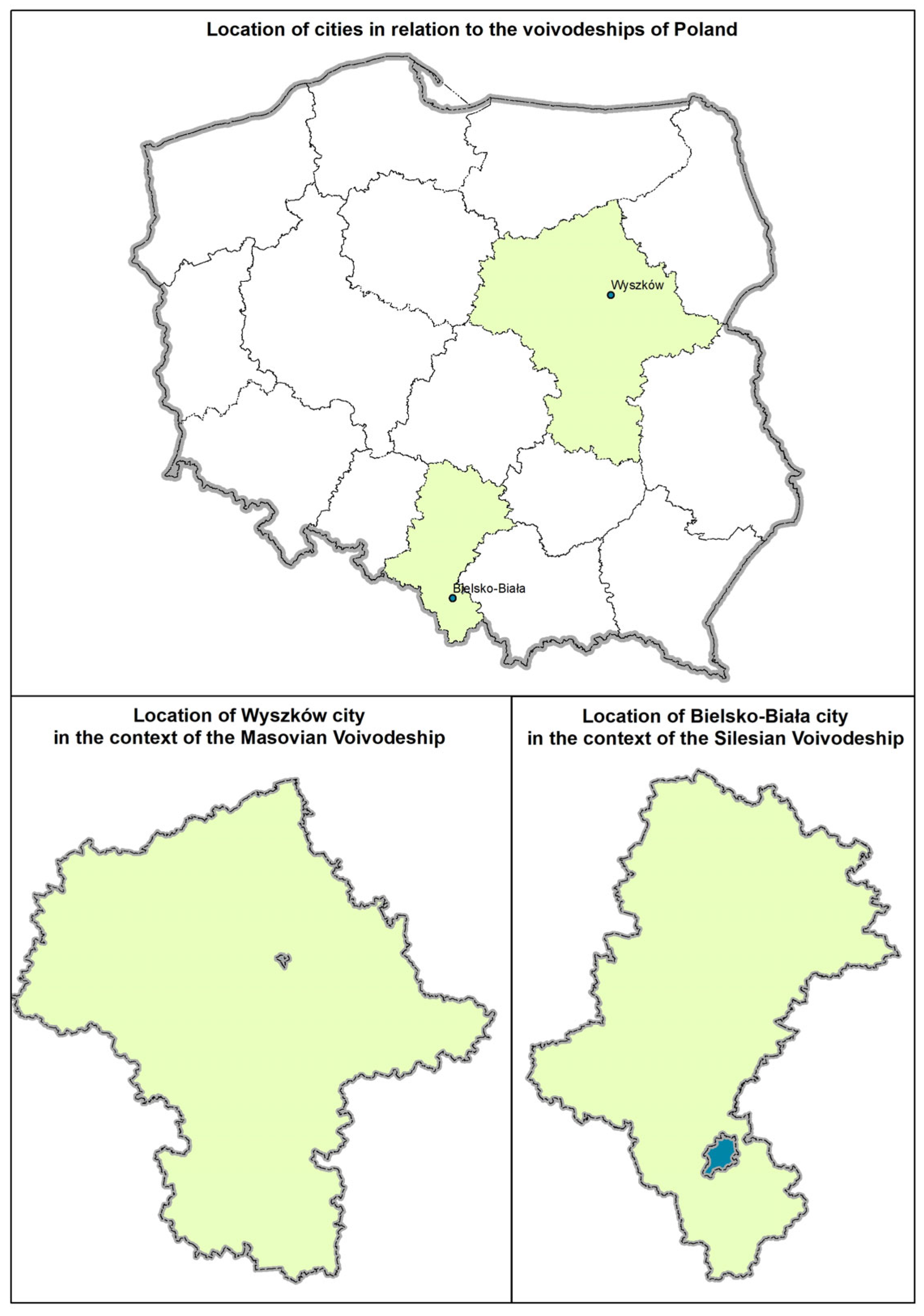
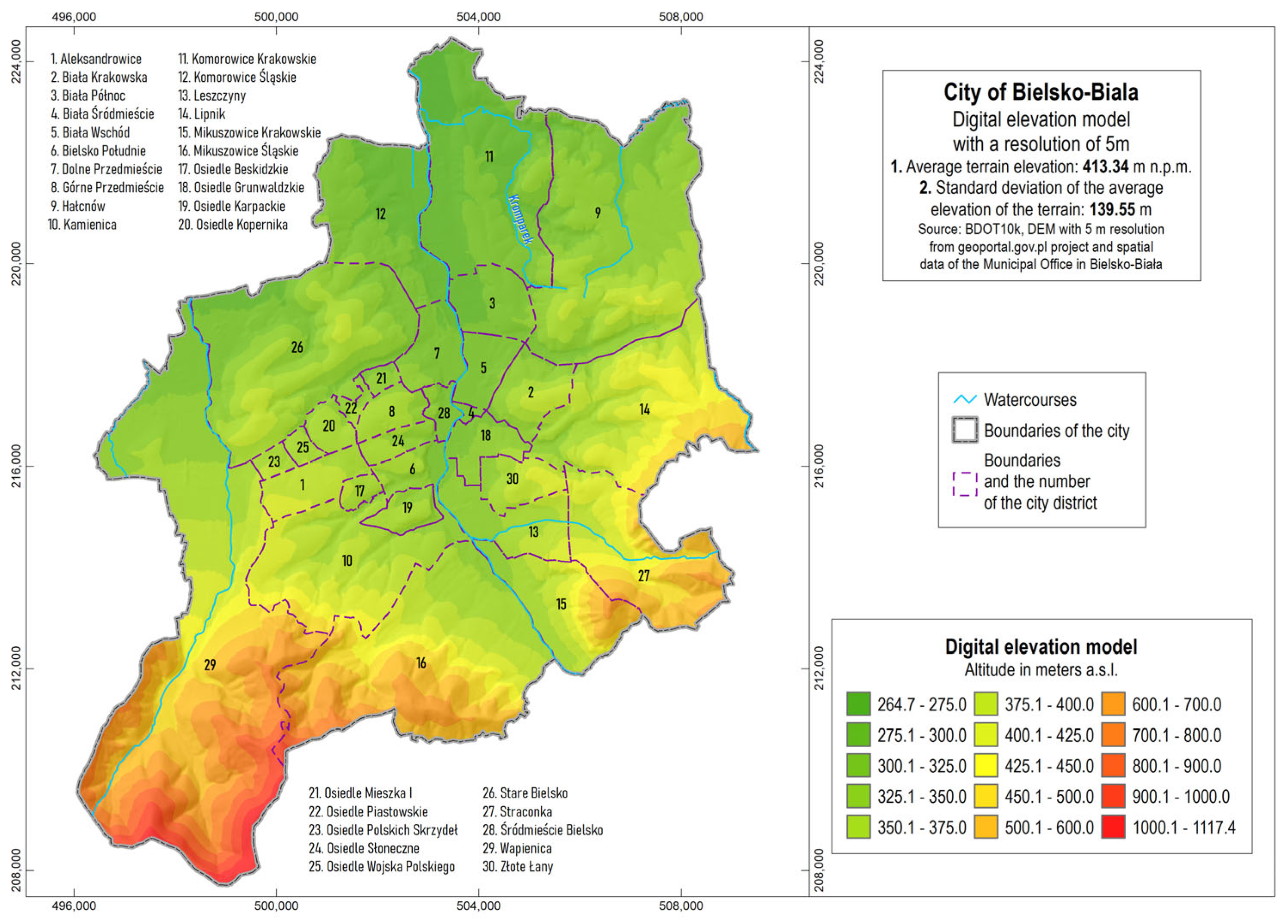


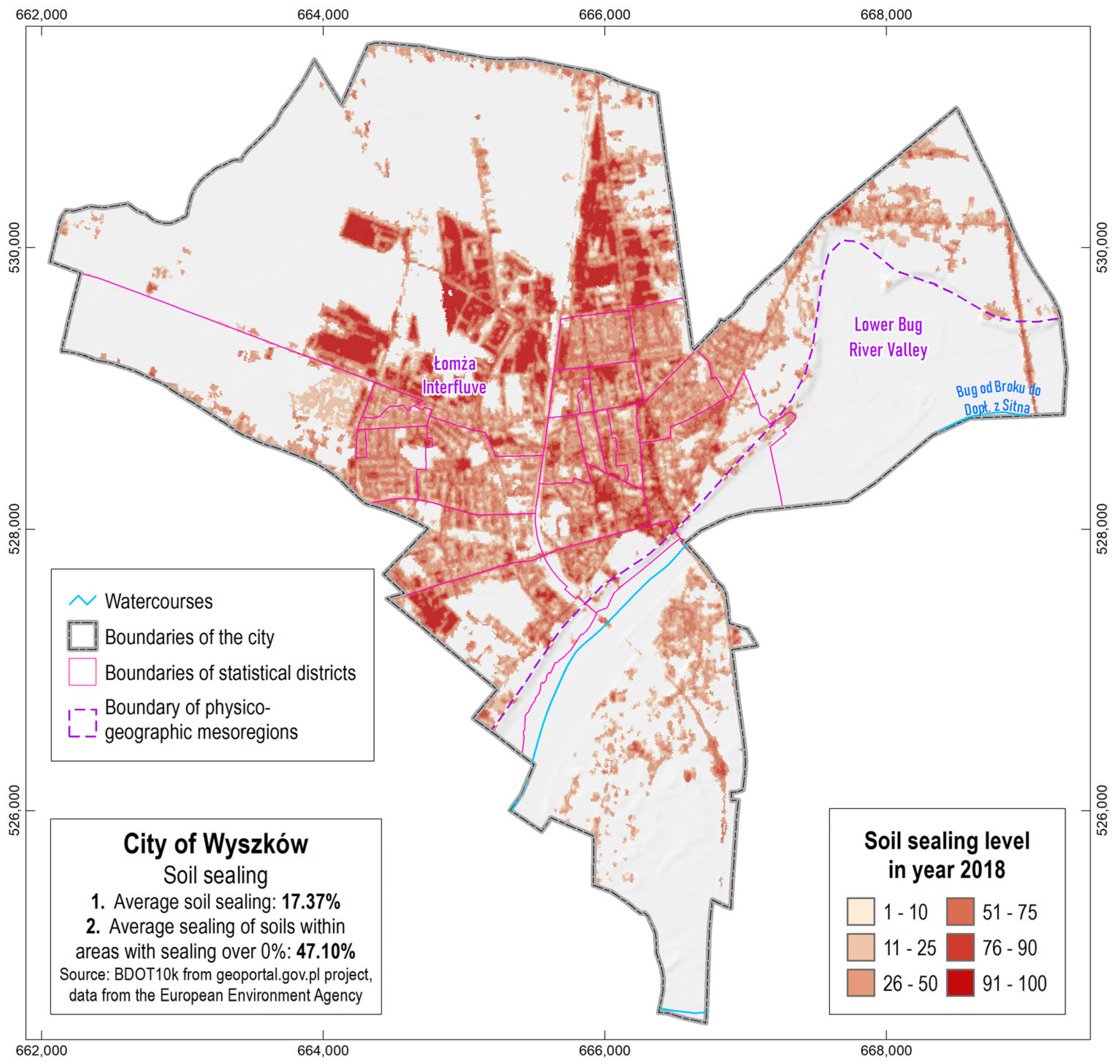
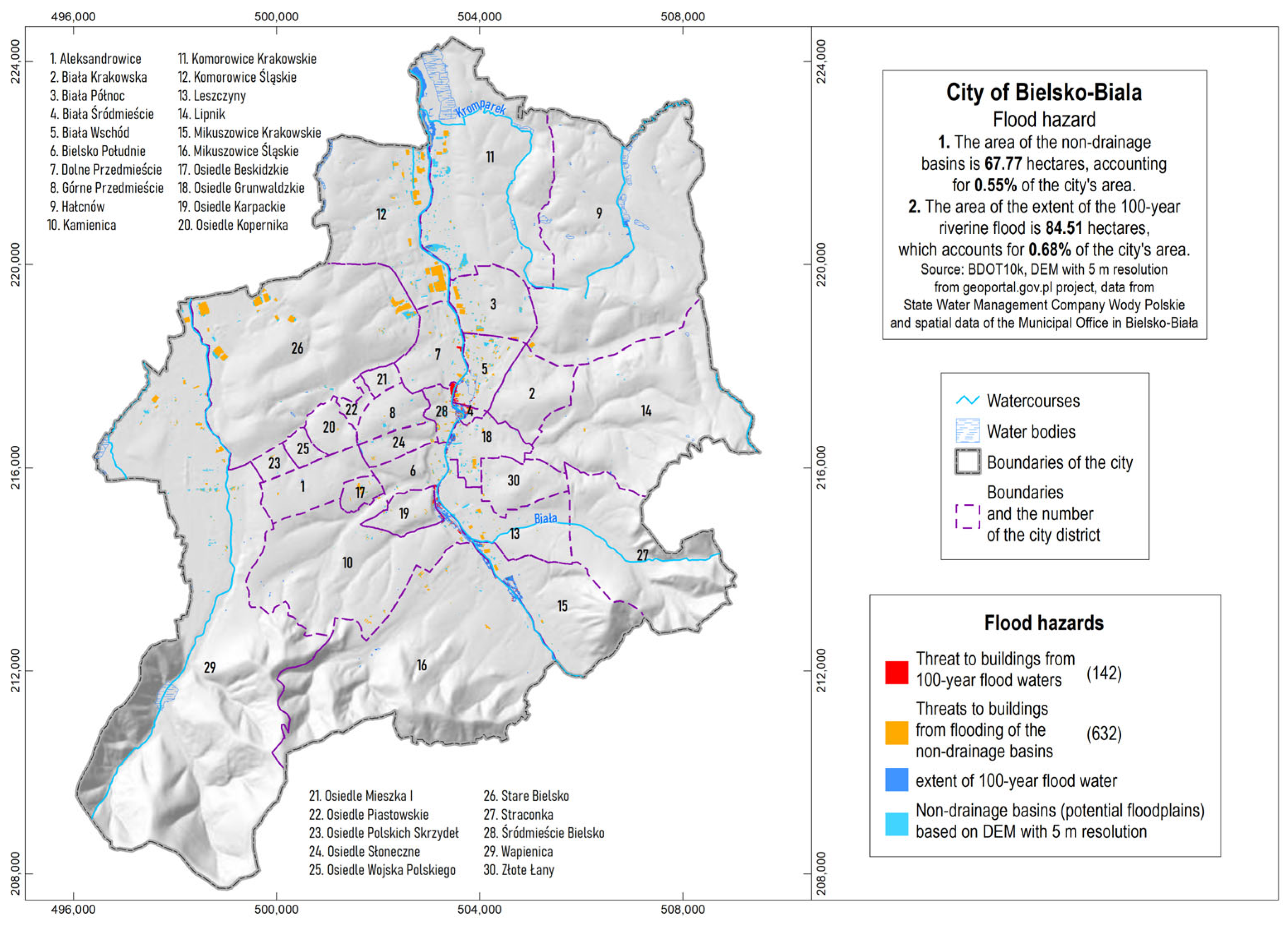
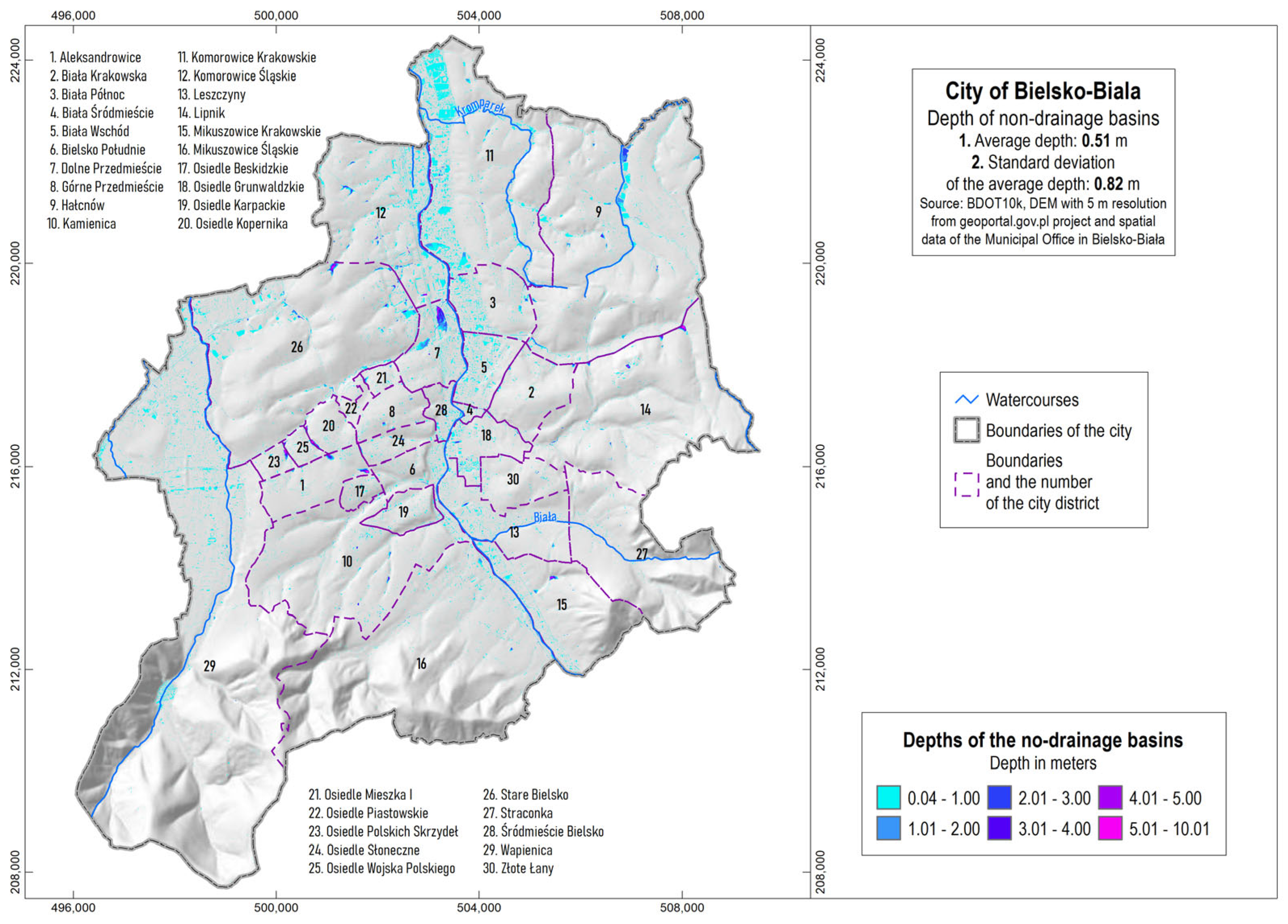
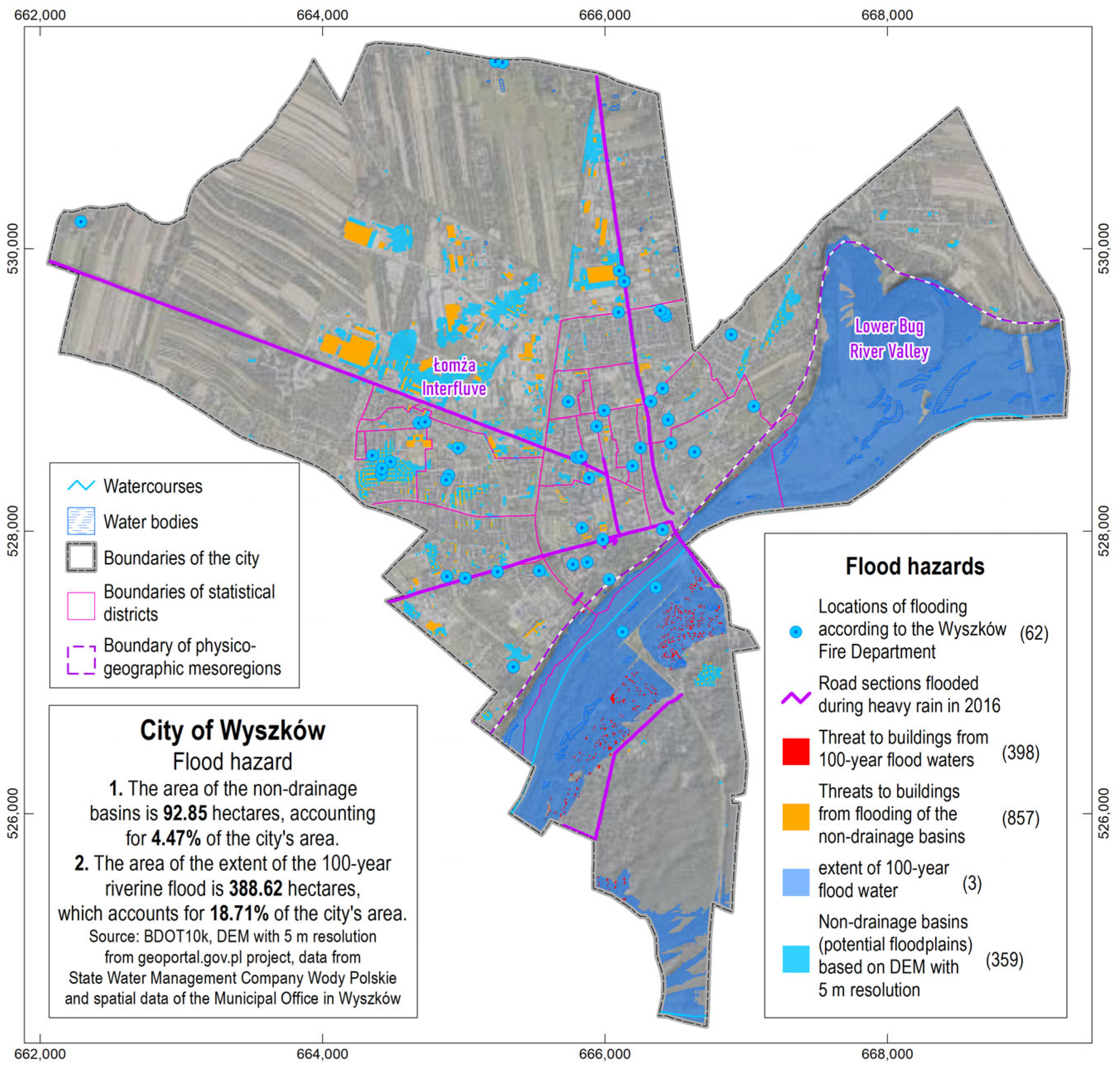
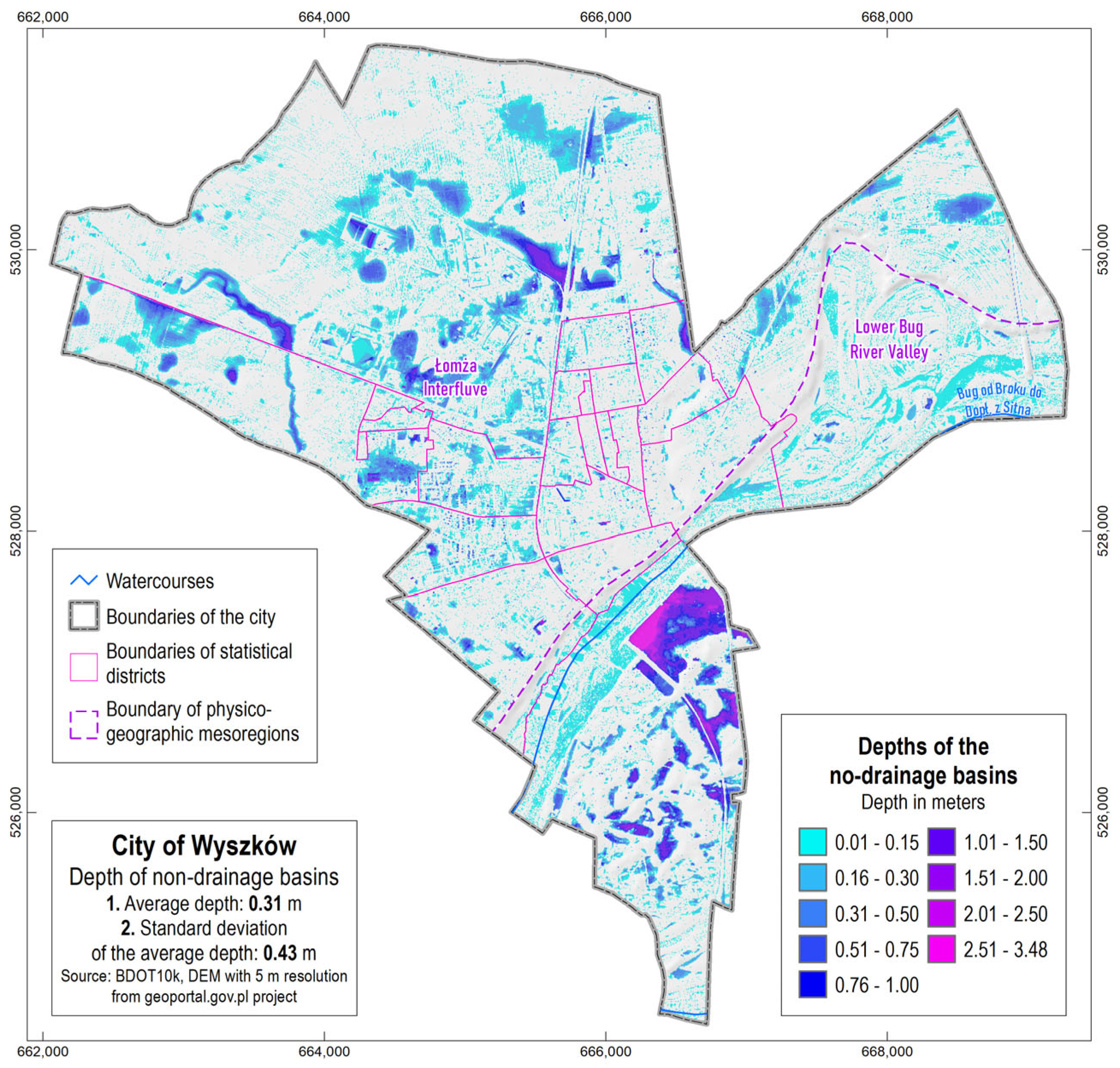
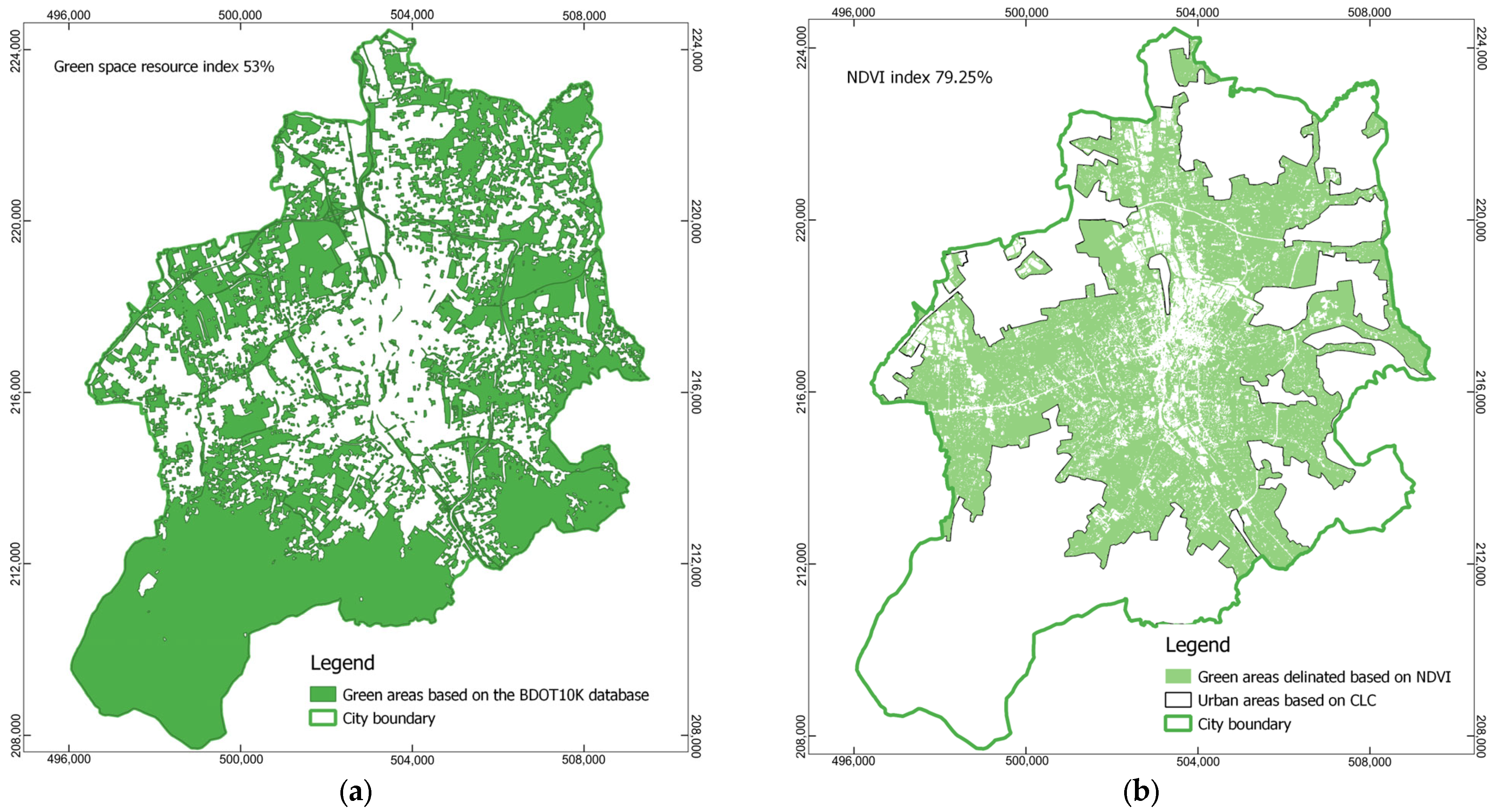
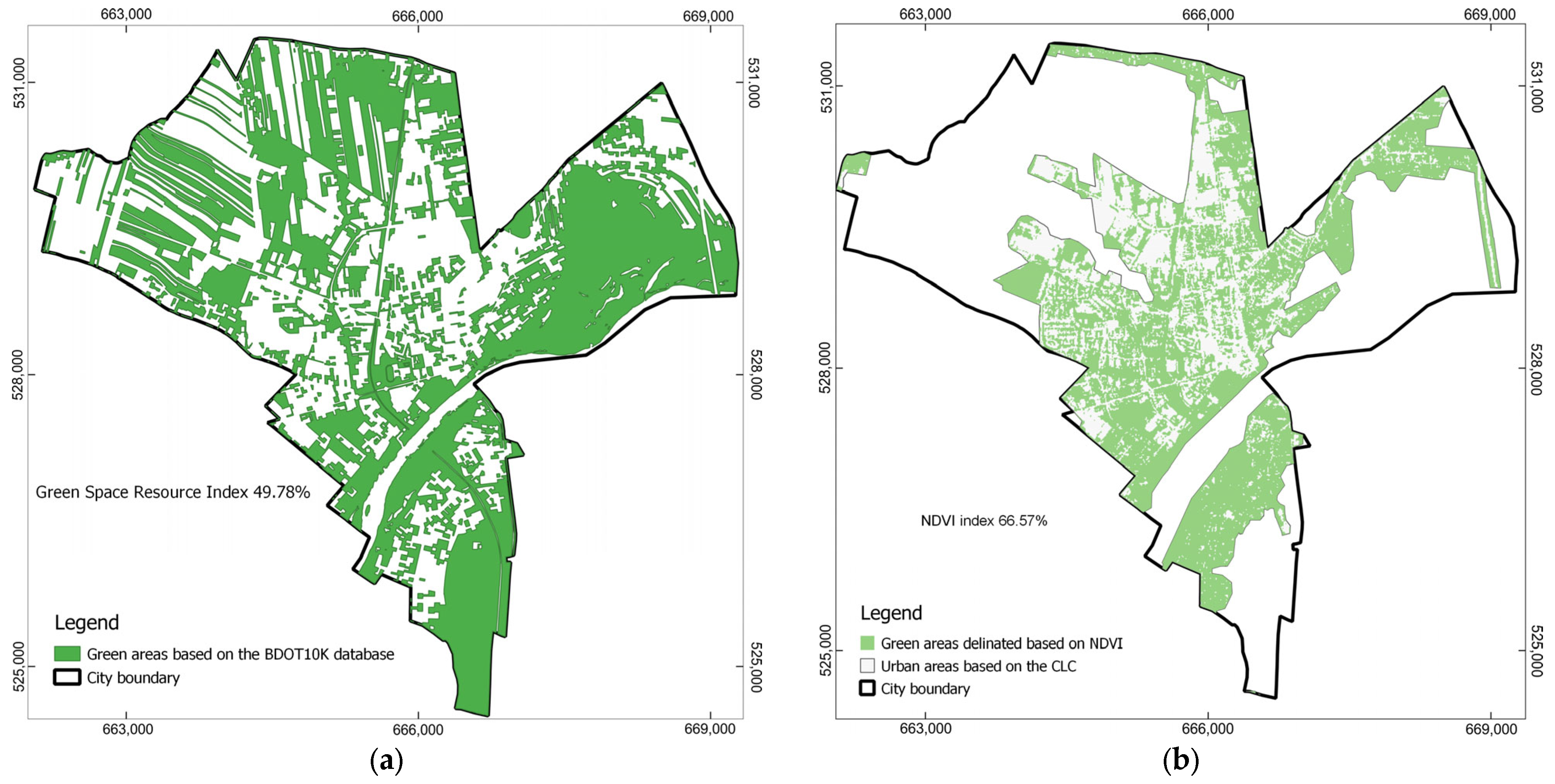
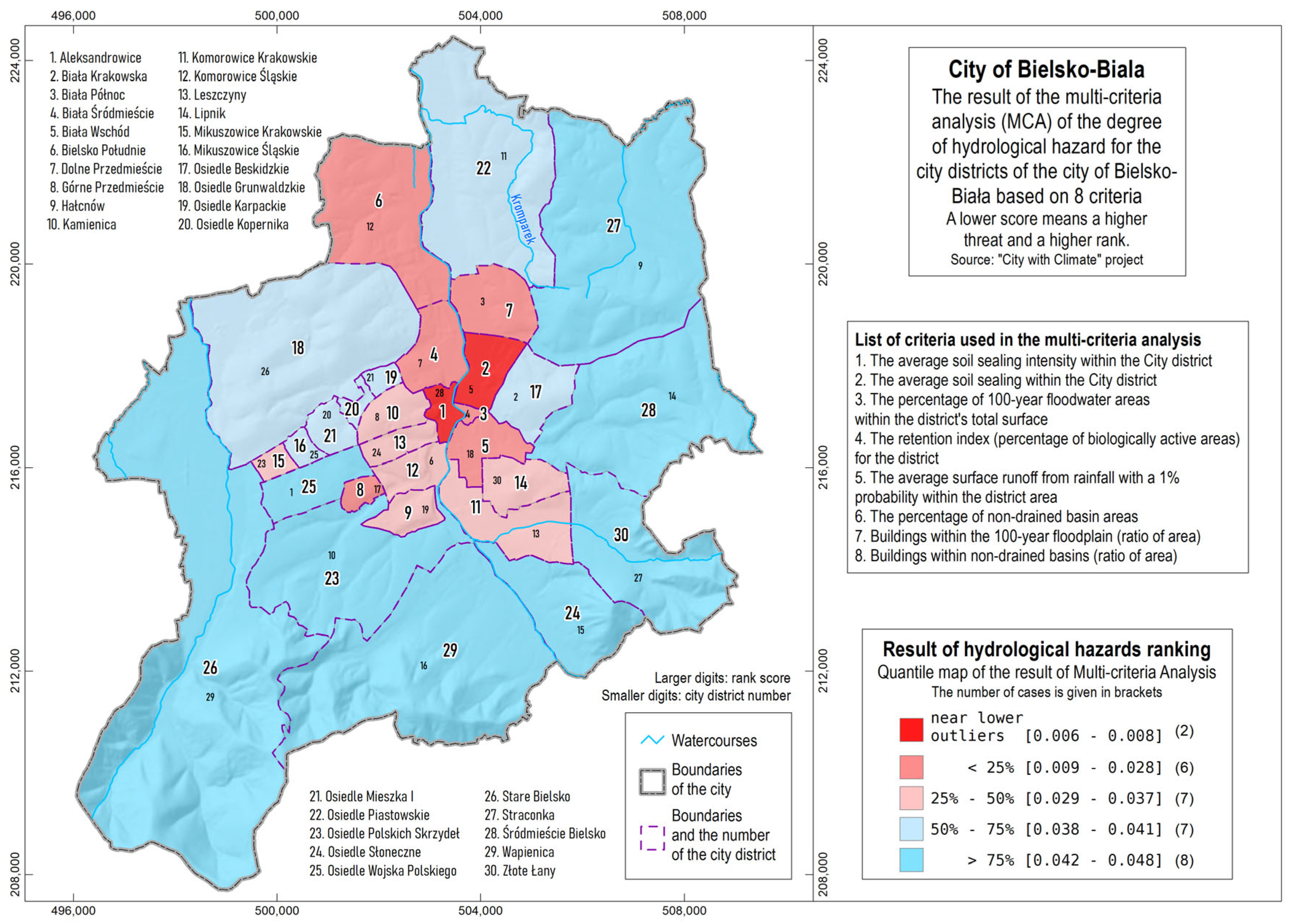

| ID | Criterion | Unit |
|---|---|---|
| 1 | Average intensity of soil sealing on spatial unit for instance city district | [%] |
| 2 | Average soil sealing | [%] |
| 3 | Percentage of areas that were affected by 100-year flooding | [%] |
| 4 | Area of buildings in the range of 100-year flood | [m2] |
| 5 | Retention potential factor (biologically active areas) | [%] |
| 6 | Average run-off resulting from 1% chance rainfall | [mm] |
| 7 | Percentage of areas covered by non-drained areas | [%] |
| 8 | Percentage of areas covered by buildings adjacent to non-drained areas | [%] |
| 9 | Area of streets prone to flooding | [m2] |
| 10 | Area covered by local flooding | [m2] |
| 11 | Length of flooded streets | [m] |
| 12 | Number of local floods on spatial unit for instance city district | [-] |
| 13 | Number of manholes on spatial unit for instance city district | [-] |
| 14 | Length the drainage network pipes | [m] |
| ID | Criterion | Weight |
|---|---|---|
| 1 | The average soil sealing intensity within the City district | 0.2968 |
| 2 | The average soil sealing within the City district | 0.1502 |
| 3 | The percentage of 100-year floodwater areas within the district’s total surface | 0.1352 |
| 4 | The retention index (percentage of biologically active areas) for the district | 0.0967 |
| 5 | The average surface runoff from rainfall with a 1% probability within the district area | 0.0477 |
| 6 | The percentage of non-drained basin areas | 0.1282 |
| 7 | Buildings within the 100-year floodplain (ratio of area) | 0.0465 |
| 8 | Buildings within non-drained basins (ratio of area) | 0.0987 |
| ID | Criterion | Weight |
|---|---|---|
| 1 | The average soil sealing intensity within the statistical district | 0.1655 |
| 2 | The average soil sealing within the statistical district | 0.0938 |
| 3 | The percentage of 100-year floodwater areas within the statistical district’s total surface | 0.0854 |
| 4 | The retention index (percentage of biologically active areas) for the statistical district | 0.0670 |
| 5 | The average surface runoff from rainfall with a 1% probability within the statistical district area | 0.0406 |
| 6 | The percentage of non-drained basin areas within the statistical district | 0.0773 |
| 7 | Buildings within the 100-year floodplain (ratio of area) | 0.0347 |
| 8 | Buildings within non-drained basins (ratio of area) | 0.0597 |
| 9 | The area of flooded roads within statistical district | 0.1785 |
| 10 | The number of points of local flooding within statistical districts | 0.1975 |
Disclaimer/Publisher’s Note: The statements, opinions and data contained in all publications are solely those of the individual author(s) and contributor(s) and not of MDPI and/or the editor(s). MDPI and/or the editor(s) disclaim responsibility for any injury to people or property resulting from any ideas, methods, instructions or products referred to in the content. |
© 2025 by the authors. Licensee MDPI, Basel, Switzerland. This article is an open access article distributed under the terms and conditions of the Creative Commons Attribution (CC BY) license (https://creativecommons.org/licenses/by/4.0/).
Share and Cite
Samborska-Goik, K.; Pogrzeba, M.; Bronder, J.; Obłój, P.; Głogowska, M. City Diagnosis as a Strategic Component in Preparing Urban Areas for Climate Change: Insights from the ‘City with Climate’ Project. Appl. Sci. 2025, 15, 4092. https://doi.org/10.3390/app15084092
Samborska-Goik K, Pogrzeba M, Bronder J, Obłój P, Głogowska M. City Diagnosis as a Strategic Component in Preparing Urban Areas for Climate Change: Insights from the ‘City with Climate’ Project. Applied Sciences. 2025; 15(8):4092. https://doi.org/10.3390/app15084092
Chicago/Turabian StyleSamborska-Goik, Katarzyna, Marta Pogrzeba, Joachim Bronder, Patrycja Obłój, and Magdalena Głogowska. 2025. "City Diagnosis as a Strategic Component in Preparing Urban Areas for Climate Change: Insights from the ‘City with Climate’ Project" Applied Sciences 15, no. 8: 4092. https://doi.org/10.3390/app15084092
APA StyleSamborska-Goik, K., Pogrzeba, M., Bronder, J., Obłój, P., & Głogowska, M. (2025). City Diagnosis as a Strategic Component in Preparing Urban Areas for Climate Change: Insights from the ‘City with Climate’ Project. Applied Sciences, 15(8), 4092. https://doi.org/10.3390/app15084092






